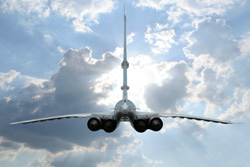Fly faster than ever!
The dream of high-speed flight has been part of human consciousness ever since the Wright Brothers took off in their first aeroplane. With the evolution of lightweight and composite materials, new technology has emerged to make faster and safer aeroplanes. The EU-funded project 'Aerodynamic and thermal load interactions with lightweight advanced materials for high-speed flight' (Attlas) investigated new materials and simulation tools that could be used for supersonic and hypersonic flight. The materials examined had the potential to withstand ultra high temperatures and heat variations above the speed of Mach 3, significantly higher than the 2.35 speed of the legendary Concorde. Project scientists re-examined traditional design and lift/drag ratio of high-speed planes, focusing on cooling capabilities and reducing sonic boom. It studied airframe, propulsion systems and aerothermal loading in on-ground experiments using ceramic matrix composites (CMCs) and heat-resistant metals. Experiments on CMC combustion chambers yielded overall thermal efficiency increases, and new cooling models using different approaches were stipulated for two aircraft configurations with Mach 3 and Mach 6 speeds. The project team studied three general classes of materials, namely metallic hollow-sphere packings (HSP), ultra high temperature ceramics (UHTC) and CMCs. It also experimented with different kerosene and cryogenic fuels with emphasis on reducing NOx emissions. Attlas was able to achieve high speeds around Mach 3.5 based on newly-designed kerosene propulsion systems. This translates to a 300 tonne gross takeoff weight and a 200 passenger aircraft displaying a range beyond 10,000 km after a 150 tonne fuel burn. While the Mach 6 model proved more challenging and requires more research and development, much progress towards hypersonic flight was achieved, holding a promising future in this direction.







